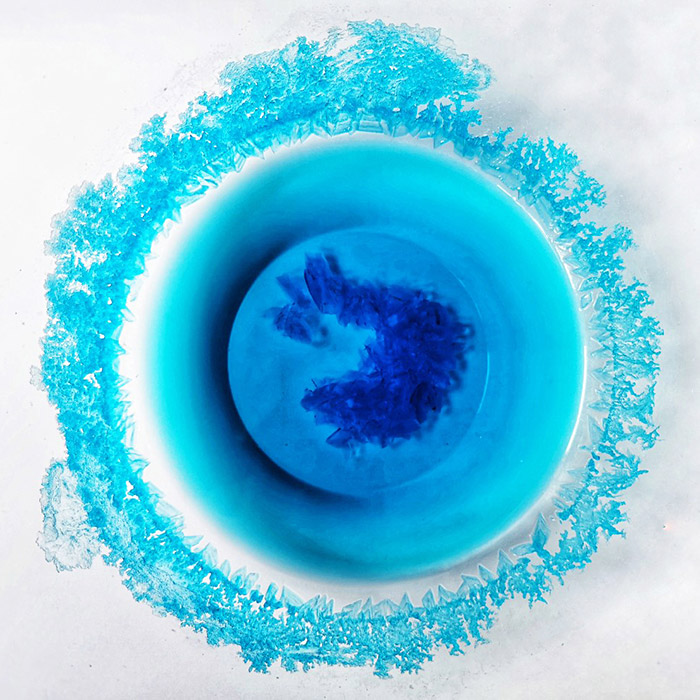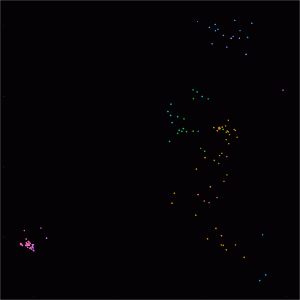Visual artist, Elaine Ford, is one of the five artists that responded to the call for proposals in March 2020 and participated in the Space and Satellites Artist in Residence programme at Inspace.
During the artist residency, Elaine experimented with growing salt crystals to reflect the fragility of our ocean ecosystems.
Using puffin movement and ocean data, Elaine explores the impermanence and the interconnections of our living planet. The Saltworks captures moments of puffin flight, swimming and diving. The puffin movements, relating to the depth of the sea, are transformed through salt crystallisation as an artmaking process.
Multiple experiments revealed the dominance of repeating patterns in the salt crystal formations. The crystal structures are analogous to topography: the building of matter, minerals, layers of sediment over time denote notions of memory, time and transformation.
THE DATA
Fascinated by the power of satellite technology to enable the conservation of wildlife and natural habitat, and with the realisation that birds can act as environmental sensors, Elaine partnered with the Royal Society for Protection of Birds (RSPB).
The RSPB had obtained data from Project Puffin about the movement of birds in the north of Scotland. Small tags record the movement of puffins as they fly vast distances, feed, swim, and dive as deep as 200ft. The GPS data is taken at regular intervals over land and sea during their breeding season.
The data revealed that puffins spend most of their lives at sea. Exploring visuals of the sea, Elaine found that most images are of the sea surface. Bathymetric data and Sentinel-2 Earth Observation data allowed Elaine to sense the ocean and harness the movement of puffins who were very active during both day and night.
Collaborating with Space Intelligence, she created a digital tapestry based on the GPS signal of one puffin, from Fair Isle, Scotland over 1 day, with white and blue crystals corresponding to day and night. The length of the crystal relates to the depth of the ocean at that space and time.
THE CREATIVE PROCESS
Drawing from writings, poems, academic papers, journaling and sketching, Elaine investigated ways to interpret GPS data. Realising puffins’ connection with – and awareness of – their environment, she studied the interconnections between life and the ocean.
Elaine became fascinated with the sensuous aspects of the ocean, what we as humans can’t sense but other animals can. Enchanted by the mysteries behind the movement of puffins and their ability to navigate vast distances and return back to their exact birthpalce after years of being in the open seas, she explored the idea of mental maps: water having memory, layers, communication and vibration of the sea floor.
Drawing from the sea – both figuratively and literally – Elaine experimented with growing salt crystals to reflect the fragility of our ocean ecosystems. Puffins are a red-listed species, with climate change as a major threat.
Using different salts, water, varying solution, temperature and light, Elaine explores new textures, structure and growth of crystals, manipulating the salt to create pathways for crystal growth that map the patterns of the natural world.

COLLABORATIONS & ACKNOWLEDGEMENTS
This artwork was created in partnership with Royal Society Protection of Birds using Global Positioning System data that is part-funded by National Lottery Heritage Fund. Project Puffin expertise in understanding puffin behaviour and habitat modelling is instrumental to the creative process. RSPB Conservation Scinetist, Connie Tremlett kindly presented Puffin Project and Puffazzi citizen science project in the artwork in progress talk.
Data visualisations were instrumental to the development of the work, as were artistic and technical support from Ray Interactive and Space Intelligence.

Elaine is a visual artist working in mixed media, glass sculpture, installation and painting. With a BSc in Biology with Ecology, integrating MSc Tropical Biodiversity, and a BA in Fine Art with Digital Crafting in Glass from Edinburgh College of Art, Elaine explores the interplay between science, technological innovation, biodiversity conservation and adventure. Her work focuses on the creation of immersive experiences to engage with remote landscapes and wild animals.
In collaboration with Wild Immersion, she has exhibited immersive content in Paris, Los Angeles, at Burning Man and at home in Edinburgh. Elaine is currently developing a long-term project exploring the application of 360 film-making techniques in the Okavango Delta, to help diverse communities around the world experience wildlife up-close and engage with the latest conservation issues.
You can connect with Elaine on Twitter @ElaineDFord and Instagram @elaineford.
